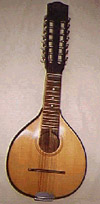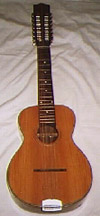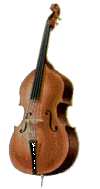Rondalla Instruments
In a standard Filipino rondalla, one would typically find the instruments bandurria, laud, octavina, guitarra, and bajo de uñas, or double bass. These instruments possess similarities in structure and are played with a plectrum made out of turtle shell. Except for the guitar and bass guitar (double bass), all are 14-stringed consisting of six sets of strings (F# B E A D G) tuned in the intervals of fourths, each set consisting of 1, 2, or 3 strings. The purpose of the doubling or tripling of strings is to produce better sound and increase tone volume.
 bandurria |
 laud |
 octavina |
 guitarra (guitar) |
 bajo de uñas (double-bass) |
The Parts

The main parts of the stringed instruments of the rondalla are basically the same. A hollow body (sound box) constructed of a sound board (top plate), which is attached to a back board (back plate) by side walls (rims) forms the main body of the instrument. The sound board picks up and amplifies the vibrations of the strings. The nice-figured body (sound box) is attached to one end of a narrow neck against which the strings can be shortened by pressing the fingers on the fingerboard to vary the vibrating length and thus the pitch. The neck ends in the tuning head which has the worm and gear mechanism to adjust the tension of the strings when tuning the instrument. There is a string holder (tailpiece) at the bottom of the body and a bridge on which the strings are stretched, so that they can vibrate freely.
The sound holes with a round shape, except the laud which is f-shape, greatly influence the timbre of the instrument. Basically, they communicate the volume of air inside the instrument with the outside air which is the medium in which the waves are carried from the instrument. The size and openness of the holes influence the frequency of the vibrating mass of air within the instrument and therefore the selective reinforcement of certain notes. The holes also influence the flexibility of the soundboard and consequently affect its vibrational patterns.
Tops, backs, and sides are carefully selected and graduated to enhance their natural attributes. Every piece of wood from the neck to the smallest brace is acoustically matched to obtain the highest performance from each instrument. The wood of langka, kamagong, narra, ballatinao, tanguile, and Philippine mahogany are generally used as materials for the construction of the instrument. Some instruments may contain imported pine wood and rosewood.
The Orchestration
In an 8-member rondalla, it is advisable to have 4 bandurrias, 1 laud, 1 octavina, 1 guitar, and 1 double bass. The 30-member group has 16 bandurrias, 3 piccolos, 3 lauds, 3 octavinas, 3 guitars, and 2 basses.The number of percussion instruments in both small and large combination is optional.
In the modern version, these instruments can portray the corresponding tones of orchestral instruments. The bandurria does the role of the first violin, the clarinet, the flute, and the trumpet. Its lowest note is small F# while its highest is three-line G. The laud, which is at times interchanged with the octavina, performs the role of the viola, the cello, the bassoon, the horn, or the trombone in the orchestra. Its range extends from great F# to two-line G. The octavina carries the same range as the laud. The guitar furnishes the chords and the contra-bass. It is notated an octave higher than its actual sound. Its range extends from great E to three-line E. The bassdguitar supplies the bass in the harmony in the same manner as the the contra-bass does in the orchestra. Like the guitar, the bass guitar is notated an octave higher than its real sound which is from contra-E to small A.
Other instruments in the string and percussion sections are added when the rondalla must assume a symphonic stature. In this case the number of players increase proportionately doubling or tripling the number of original and authentic instruments of the group. The bass drum, snare drum, cymbal, triangle, tambourine, marimba, timpani and kettle may be added for the rhythmic effects. The UPA&F Rondalla uses the maracas in one of their musical rendition. Maracas are gourd or gourd-shaped rattles filled with seeds or pebbles and used often in pairs as a rhythmic instrument.
Bandurria

 Pear-shaped body with a round sound hole, the bandurria is the mainstay of the group. This instrument usually carries the main melody and plays melodies and counterparts. Bandurrias may be divided into first, second, and third, each one playing a different part.
Pear-shaped body with a round sound hole, the bandurria is the mainstay of the group. This instrument usually carries the main melody and plays melodies and counterparts. Bandurrias may be divided into first, second, and third, each one playing a different part.
TUNING
- The bandurria has six (6) sets of strings, tuned in the intervals of fourths.
- First Set (3 strings)
- Tuned to a high G (sol), the second G above the middle C (do) of the piano
- Second Set (3 strings)
- Tuned to D (re), a fourth below the high G
- Third Set (3 strings)
- Tuned to A (la), a fourth below the D
- Fourth Set (2 strings)
- Tuned to E (mi), a fourth below the A
- Fifth Set (2 strings)
- Tuned to B (si), a fourth below the E
- Sixth Set (1 string)
- Tuned to F# (fa), a fourth below the B
DIMENSIONS
|
Scale length: 12 in. (distance from the nut to the bridge)
Tuning head length:10 1/4 in. Tuning head width: 2 - 2 3/4 in. Fingerboard length: 7 1/8 in. Fingerboard width: at Nut: 2 in. at last Fret: 2 3/8 in. Frets: Total: 14 Clear of body joint: 7 (usually marked with double dots) |
Total length : 25 7/8 in.
Body length: 12 in. Body width: 10 in. Sound hole - round: 2 5/8 in. Rim depth: 3 1/8 in. Bridge width: 4 1/2 in. Bridge height: 7/16 in. Bracing: Parallel |
No. of Strings: 14
String gauges: 1st course(3 strings) G unwound steel: .008 in. 2nd course(3 strings) D unwound steel: .010 in. 3rd course(3 strings) A copper-wound steel: .018 in. 4th course(2 strings) E copper-wound steel: .026 in. 5th course(2 strings) B copper-wound steel: .032 in. 6th course(1 string) F# copper-wound steel: .040 in. |
Laud
 Shaped similar to the bandurria but bigger, the laud has a longer neck and two f-sound holes. It usually plays the lower notes in accompaniments, counterparts, and in unison with the bass. The old original laud, better known as the lute, has a round body in the shape of a half pear, a flat neck with seven or more frets, and a separate pegbox bent back at an angle.
Shaped similar to the bandurria but bigger, the laud has a longer neck and two f-sound holes. It usually plays the lower notes in accompaniments, counterparts, and in unison with the bass. The old original laud, better known as the lute, has a round body in the shape of a half pear, a flat neck with seven or more frets, and a separate pegbox bent back at an angle.
TUNING
- The laud is tuned exactly the same as the bandurria except one octave lower. This instrument has six (6) sets of strings, tuned in the intervals of fourths.
- First Set (3 strings)
- Tuned to G (sol), the first G above the middle C (do) of the piano
- Second Set (3 strings)
- Tuned to D (re), a fourth below the G
- Third Set (3 strings)
- Tuned to A (la), a fourth below the D
- Fourth Set (2 strings)
- Tuned to E (mi), a fourth below the A
- Fifth Set (2 strings)
- Tuned to B (si), a fourth below the E
- Sixth Set (1 string)
- Tuned to F# (fa), a fourth below the B
DIMENSIONS
|
Scale length: 19 1/4 in. (distance from the nut to the bridge)
Tuning head length:10 1/2in. Tuning head width: 2 3/8 - 2 5/8 in. Fingerboard length: 13 1/2 in. Fingerboard width: at Nut: 2 in. at last Fret: 2 3/8 in. Frets: Total: 18 Clear of body joint: 12 (usually marked with double dots) |
Total length : 33 in.
Body length: 12 7/8 in. Body width: 11 3/8 in. Sound hole - f : 4 1/8 in. long Rim depth: 3 3/8 in. Bridge width: 4 1/4 in. Bridge height: 7/16 in. Bracing: Parallel |
No. of Strings: 14
String gauges: 1st course (3 strings) G unwound steel: .010 in. 2nd course (3 strings) D unwound steel: .012 in. 3rd course (3 strings) A copper-wound steel: .018 in. 4th course (2 strings)E copper-wound steel: .032 in. 5th course (2 strings) B copper-wound steel: .040 in. 6th course (1 string) F# copper-wound steel |
Octavina

 Formed like a guitar with shorter neck and with round sound hole, the octavina, like the laud, plays the lower notes in accompaniments, in counterparts, and in unison with the bass.
Formed like a guitar with shorter neck and with round sound hole, the octavina, like the laud, plays the lower notes in accompaniments, in counterparts, and in unison with the bass.
TUNING
- The octavina is tuned exactly the same as the laud (and an octave lower than the bandurria) and is interchangeable with it. This instrument has six (6) sets of strings, tuned in the intervals of fourths.
- First Set (3 strings)
- Tuned to G (sol), the first G above the middle C (do) of the piano
- Second Set (3 strings)
- Tuned to D (re), a fourth below the G
- Third Set (3 strings)
- Tuned to A (la), a fourth below the D
- Fourth Set (2 strings)
- Tuned to E (mi), a fourth below the A
- Fifth Set (2 strings)
- Tuned to B (si), a fourth below the E
- Sixth Set (1 string)
- Tuned to F# (fa), a fourth below the B
DIMENSIONS
|
Scale length: 19 3/4 in. (distance from the nut to the bridge)
Tuning head length:10 1/4 in. Tuning head width: 2 1/2 - 2 3/4 in. Fingerboard length: 13 1/2 in. Fingerboard width: at Nut: 2 in. at last Fret: 2 7/8 in. Frets: Total: 18 Clear of body joint: 12 (usually marked with double dots) |
Total length : 34 3/4 in.
Body length: 18 3/4in. Body width @upper bout: 11 5/16 in. Body width @lower bout: 15 1/8 in. Sound hole - round: 3 3/8 in. Rim depth: 3 13/16 in. Bridge width: 3 1/8 in. Bridge height: 5/8 in. Bracing: Parallel |
No. of Strings: 14
String gauges: 1st course(3 strings) G unwound steel: .010 in. 2nd course(3 strings) D unwound steel: .012 in. 3rd course(3 strings) A copper-wound steel: .018 in. 4th course(2 strings) E copper-wound steel: .032 in. 5th course(2 strings) B copper-wound steel: .040 in. 6th course(1 string) F# copper-wound steel: .048 in. |
Guitar
 Six-stringed with long, fretted neck which can be plucked with the fingers or with a plectrum, larger body than the octavina with round sound hole, the guitar (guitarra) plays the accompaniments, plays melodies and counterparts, and provides the permanent rhythm for the group using chordal and arpeggio accompaniments. This instrument brought into the Philippines by the Spaniards have inspired the development of the rondalla in the country. Filipino ingenuity produced several other instruments modeled after the guitar which soon joined it in musical group which develped into the rondalla.
Six-stringed with long, fretted neck which can be plucked with the fingers or with a plectrum, larger body than the octavina with round sound hole, the guitar (guitarra) plays the accompaniments, plays melodies and counterparts, and provides the permanent rhythm for the group using chordal and arpeggio accompaniments. This instrument brought into the Philippines by the Spaniards have inspired the development of the rondalla in the country. Filipino ingenuity produced several other instruments modeled after the guitar which soon joined it in musical group which develped into the rondalla.
TUNING
- The 6-string guitar is tuned as follows:
- First String
- E (mi), the first E above the middle C of the piano
- Second String
- B (si), going lower
- Third String
- G (sol)
- Fourth String
- D (re)
- Fifth String
- A (la)
- Sixth String
- E (mi)
DIMENSIONS
|
Scale length: 25 5/8 in. (distance from the nut to the bridge)
Tuning head length: 6 13/16 in. Tuning head width: 2 5/8 - 2 7/8 in. Fingerboard length: 25 1/2 in. Fingerboard width: at Nut: 2 in. at last Fret: 2 5/8 in. Frets: Total: 19 Clear of body joint: 12 (usually marked with double dots) |
Total length : 39 in.
Body length: 18 3/4in. Body width @upper bout: 11 5/16 in. Body width @lower bout: 15 1/8 in. Sound hole - round: 3 3/8 in. Rim depth: 3 13/16 in. Bridge width: 3 1/8 in. Bridge height: 5/8 in. Bracing: Parallel |
No. of Strings: 6
String gauges: 1st course (1 string) E nylon: .013 in. 2nd course (1 string) B nylon: .017 in. 3rd course (1string) G nylon: .026 in. 4th course (1 string) D copper-wound steel: .036 in. 5th course (1 string) A copper-wound steel: .046 in. 6th course (1 string) E copper-wound steel: .058in. |
Double Bass
 The double bass, also called bass VIOL or contrabass, is four-stringed, the largest instrument of the rondalla, shaped like the violin with two f sound holes, provides the fundamental tone, and reinforces the rhythm. Until 1910, the bass guitar was just slightly bigger than the ordinary guitar and was played in the same manner as the guitar, placed on the lap. Later, the bass guitar adapted a tailpiece and was henceforth played with the player standing up. With the tailpiece this instrument is adjustable to suit the player's height. In the interior of the bass, a small piece of round wood is fixed immediately behind the right foot of the bridge, to act as a support. It is called the "sound post." Under the bridge's left foot a strip of wood known as the "bass bar" is glued lengthways along the belly. It has different sizes: 1/2, 3/4, 7/8, or a full size. A 1/2 or 3/4 size double bass is usually used in the elementary grades, and 3/4, 7/8 or a full size double bass is for junior or senior high school students depending on the person's physical stature.
The double bass, also called bass VIOL or contrabass, is four-stringed, the largest instrument of the rondalla, shaped like the violin with two f sound holes, provides the fundamental tone, and reinforces the rhythm. Until 1910, the bass guitar was just slightly bigger than the ordinary guitar and was played in the same manner as the guitar, placed on the lap. Later, the bass guitar adapted a tailpiece and was henceforth played with the player standing up. With the tailpiece this instrument is adjustable to suit the player's height. In the interior of the bass, a small piece of round wood is fixed immediately behind the right foot of the bridge, to act as a support. It is called the "sound post." Under the bridge's left foot a strip of wood known as the "bass bar" is glued lengthways along the belly. It has different sizes: 1/2, 3/4, 7/8, or a full size. A 1/2 or 3/4 size double bass is usually used in the elementary grades, and 3/4, 7/8 or a full size double bass is for junior or senior high school students depending on the person's physical stature.
TUNING
- The bass guitar (bajo de uñas) has 4 strings and is tuned in fourths.
- First String
- G (sol), the first below G below the middle C of the piano
- Second String
- D (re), going lower
- Third String
- A (la)
- Fourth String
- E (mi)
DIMENSIONS
|
Scale length: in. (distance from the nut to the bridge)
Tuning head length: in. Tuning head width: in. Fingerboard length: in. Fingerboard width at Nut: in. at last Fret: in. Frets: Total: Clear of body joint: (usually marked with double dots) |
Total length : in.
Body length: in. Body width: in. Sound hole - f: in. Rim depth: in. Bridge width: in. Bridge height: in. Bracing: |
No. of Strings: 4
String gauges: 1st course(1 string) G unwound steel: .076 in. 2nd course(1 string) D unwound steel: .094 in. 3rd course(1 string) A copper-wound steel: .104 in. 4th course(1 string) E copper-wound steel: .140 in. |
Source:
1978. Filipino Heritage: The Making of a Nation, Volume 9, ed. Alfredo Roces, Manila, Philippines: Lahing Pilipino Publishing.
Home > UPAFR Organization > Instruments



